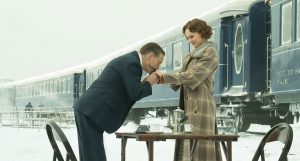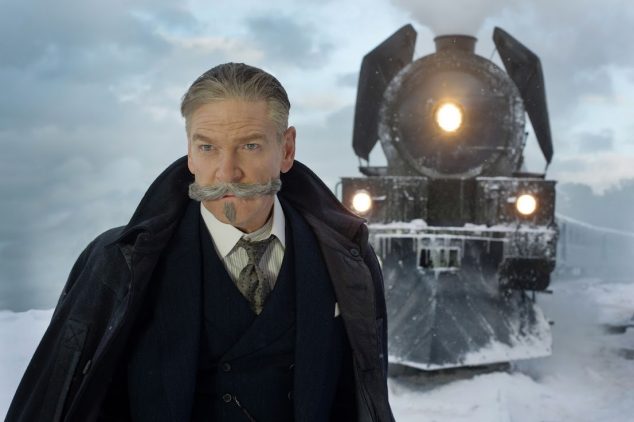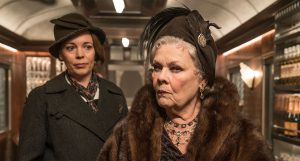There is something special about train travel. Paraphrasing from the film and the novel, a group of strangers journey together in close quarters. They share a whole trip, and afterwords they go their separate ways. It’s a perfect exercise in people watching. And apparently, it’s also perfect for a murder mystery. Kenneth Branagh directs and stars in the newest incarnation of Agatha Christie’s Murder on the Orient Express. The new spin on the classic tale proves to be a stylish and well-made take, even if it doesn’t reinvent the wheel.
Planning on taking a vacation from his demanding and ever-present job of being a famous detective, Hercule Poirot boards the Orient Express. Sure enough, one of the passengers turns up dead, stabbed several times. On top of this, an avalanche stops the train in its tracks, hindering Poirot’s trip home. The man can never get a break. He reluctantly takes up the case, and interviews the who’s who of interesting characters aboard the train.
And what a cast it is. Most of the characters are quite intriguing, aided by the heavy-hitting actors who play them. Judi Dench plays a Russian princess, Willem Dafoe an austere Austrian professor, and Michelle Pfeiffer a mysterious socialite. Then you have a doctor, a governess, and a lawyer, played by Leslie Odom Jr., Daisy Ridley, and Josh Gad, respectively. The list goes on, but there is a certain point at which actors just either don’t have enough screen time or make enough of an impact to stand out in the film. Thankfully, the film shies away from the bigger problem that often plagues large all-star casts in that in never feels bloated. Overall, the cast members use their time wisely and complement each other well.
Murder mysteries often have large casts and involve several interrogations. Branagh made the smart decision to intercut the interrogations with each other while staging them in various locations in and around the train. It’s a small choice but an important one, as it allows the characters to be introduced and get the evidence out there as efficiently as possible. In lesser hands, these requisite scenes could’ve felt repetitive.
The film also has an eye for style. The cinematography switches between a grand scale and a claustrophobic one. Shots of the train chugging through cities and snowy landscapes are juxtaposed with views inside the tiny halls and compartments of the train itself as the passengers are forced to come to terms with their situation. This makes sense. Travel can be paradoxically liberating and stifling, and the camera angles convey both of these feelings.
Since the tale is neither new nor adapted for the screen for the first time here, there are a few changes. The film tweaks the personalities of some characters and completely changes the identities of others. Some of these differences from the source material feel fresh and interesting, while others seem unnecessary. There are also a few more action-y scenes thrown in, which help break up what is otherwise a bunch of people talking to each other on a train. Most notably, this is very much a film for modern times, which works to its benefit. It explores racial and religious tensions, such as in an added prologue that takes place in Jerusalem. These themes are handled tactfully, and fit in perfectly in a work about justice, morality, and the circumstances that force people together from all different backgrounds.
The area where the film falters is its tone. It starts off lighthearted, even comedic. Several bits made me chuckle, such as a recurring gag of Poirot getting a kick out of reading Charles Dickens. Naturally, the tone gets slightly heavier in both the book and the film once the murder is committed, but the movie takes this a step further when Poirot and those around him plunge deep into despair. The change proves to be a jarring one. While the movie goes on to own its more emotional scenes, its mood never quite regains its balance, much like the derailed locomotive lying askew in the snow.
For me, train travel is my preferred mode of transportation. I always welcome films that revolve around it. So while the new Murder on the Orient Express traverses territory that has been crossed before, it’s a welcome addition to the train trip canon. It brings to life a classic story while breathing new life into it. Even if it doesn’t always fire on all cylinders, it ends up being a trip worth taking.
Summary
Beautifully shot and featuring a great ensemble cast, Murder on the Orient Express is a sleek, modern retelling of the classic whodunit. While it falters in some places, it never runs out of steam.





